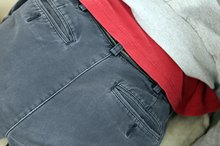What does fact checked mean?
At Healthfully, we strive to deliver objective content that is accurate and up-to-date. Our team periodically reviews articles in order to ensure content quality. The sources cited below consist of evidence from peer-reviewed journals, prominent medical organizations, academic associations, and government data.
The information contained on this site is for informational purposes only, and should not be used as a substitute for the advice of a professional health care provider. Please check with the appropriate physician regarding health questions and concerns. Although we strive to deliver accurate and up-to-date information, no guarantee to that effect is made.
Tennis Ball Therapy for Sciatica
According to the Mayo Clinic, sciatica refers to a radiating pain which traces a pattern along your sciatic nerve—your body's thickest nerve—from your low-back and posterior thigh into your leg. The Mayo Clinic's staff also make the important distinction that sciatica—also called "sciatic neuritis"—is itself not a disease or disorder, but rather, is a symptom of another problem involving your nerve, such as a herniated disc or a narrowing of your spinal canal. Using a tennis ball, in some instances, can help reduce your sciatic pain.
If you are experiencing serious medical symptoms, seek emergency treatment immediately.
Tennis Ball Therapy
Dance educator, performer and choreographer Katherine Steadman states that tennis ball therapy “uses the principles of acupressure and reflexology to relieve muscle soreness, tension and the effects of toxins in the body.” A tennis ball is used to help locate and treat tender areas in your muscles, and is particularly effective for tender points in your piriformis muscle—a muscle known by physicians to contribute to the onset of sciatica 2. Because of its frequent contribution to the onset of sciatic pain, the piriformis muscle has given rise to its own named condition: piriformis syndrome 3.
Trigger Points
What Are the Treatments for Muscle Strain of One Side of the Buttocks?
Learn More
Dr. Timothy J. Maggs, a chiropractor, suggests that trigger points—hyper-irritable nodules or bands in skeletal muscle—can accumulate in your piriformis muscle as a result of repetitive use. Trigger points alter the tone of your piriformis muscle, which in turn effects your structures and tissues—including your sciatic nerve—that lie in proximity to your piriformis muscle. Your sciatic nerve then becomes inflamed and you experience the classic sciatica symptom: radiating pain in your posterior thigh and lower leg.
How It Works
Dr. Maggs suggests that tennis ball therapy can be used to facilitate your recovery from piriformis syndrome 23. The tennis ball is used as a point-source of pressure to treat trigger points in your piriformis muscle, with the goal of reducing the hypertonicity of your muscle, restoring normal blood flow to the area and relieving the irritation on your sciatic nerve. While sitting on the floor, place a tennis ball under your gluteal muscles on the side of your body that you're experiencing radiating pain. Slowly shift your weight onto the ball and note any areas of increased tenderness; these are the locations of your trigger points. Some patients describe the tenderness as a “hurt-so-good” type of discomfort. Use a moderate amount of force to compress each painful spot for 15 to 20 seconds before you move to the next. Your total treatment time should be no more than 4 to 5 minutes per session.
- Dr. Maggs suggests that tennis ball therapy can be used to facilitate your recovery from piriformis syndrome 2.
- The tennis ball is used as a point-source of pressure to treat trigger points in your piriformis muscle, with the goal of reducing the hypertonicity of your muscle, restoring normal blood flow to the area and relieving the irritation on your sciatic nerve.
Benefits
Inflamed Trigger Points in the Forearm
Learn More
If performed properly and consistently, tennis ball therapy will help alleviate your sciatica, assuming the cause of the sciatica is due to trigger points in the piriformis muscle and not from a spinal condition causing nerve impingement, such as a herniated disc or a narrowing of the spinal canal or its outlets 2. Tennis ball therapy is a simple, convenient and cost-effective approach to the treatment of your sciatica, and can be performed at home without the supervision of a health care professional 2.
Considerations
Tennis ball therapy, while largely effective, has several limitations 2. For example, if too much weight is placed on the ball, the ball can collapse. Also, the tennis ball is not a substitute for the skilled hands of a professional bodyworker who can draw on his experience to assess your problematic areas and find latent trigger points. And if you’re experiencing sciatic pain, it’s important to immediately visit your physician so she can determine the true cause of your symptoms. Relying on tennis ball therapy for your sciatica will not be effective if there’s something more serious going on, and could delay the commencement of treatments that are appropriate for your condition 2.
Related Articles
References
- MayoClinic.com: Sciatica
- Creative Body Works: Tennis Ball Therapy
- SpineUniverse: Piriformis Syndrome
- Cass SP. Piriformis syndrome: a cause of nondiscogenic sciatica. Curr Sports Med Rep. 2015;14(1):41-4. doi:10.1249/JSR.0000000000000110
- Jankovic D, Peng P, Van Zundert A. Brief review: piriformis syndrome: etiology, diagnosis, and management. Can J Anaesth. 2013;60(10):1003-12. doi:10.1007/s12630-013-0009-5
- Bardowski EA, Byrd JWT. Piriformis injection: an ultrasound-guided technique. Arthrosc Tech. 2019;8(12):e1457–e1461. Published 2019 Nov 13. doi:10.1016/j.eats.2019.07.033
- Jankovic D, Peng P, van Zundert A. Brief review: piriformis syndrome: etiology, diagnosis, and management. Can J Anaesth. 2013;60(10):1003-12.
Writer Bio
Martin Hughes is a chiropractic physician, health writer and the co-owner of a website devoted to natural footgear. He writes about health, fitness, diet and lifestyle. Hughes earned his Bachelor of Science in kinesiology at the University of Waterloo and his doctoral degree from Western States Chiropractic College in Portland, Ore.









